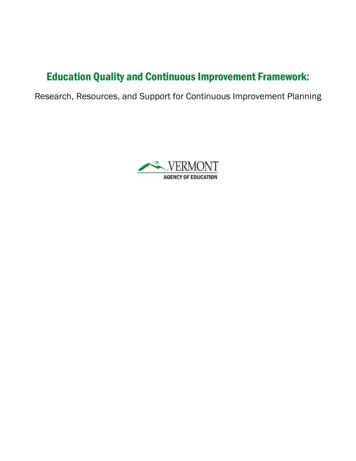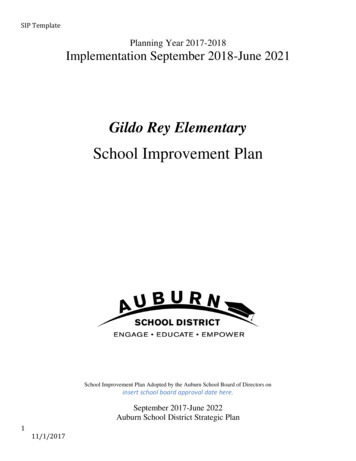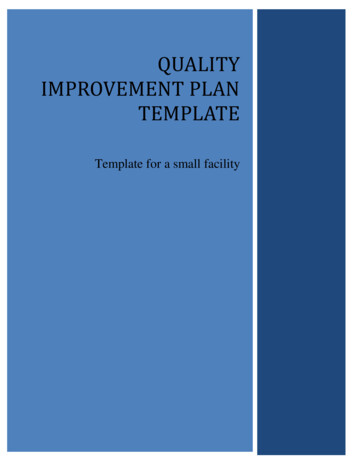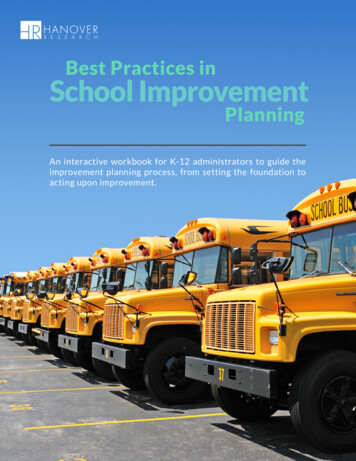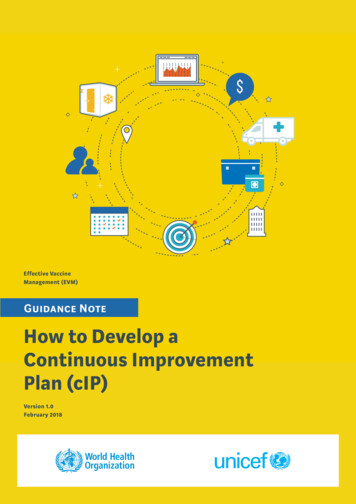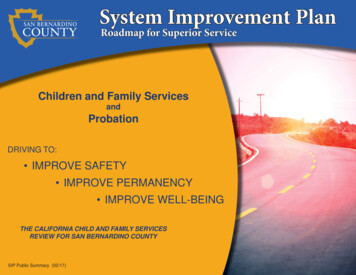
Transcription
System Improvement PlanRoadmap for Superior ServiceChildren and Family ServicesandProbationDRIVING TO: IMPROVE SAFETY IMPROVE PERMANENCY IMPROVE WELL-BEINGTHE CALIFORNIA CHILD AND FAMILY SERVICESREVIEW FOR SAN BERNARDINO COUNTYSIP Public Summary (02/17)
The Mission of Child Welfare ServicesThe County lead agencies for the California Children and Family Services Review(C-CFSR) are Children and Family Services (CFS) and the Probation DepartmentThe Probation Department protects the communitythrough assessment, treatment and control of adultand juvenile offenders by providing a range ofeffective services based on legal requirements andrecognized professional standards.Children and Family Services protects endangered children, preserves andstrengthens their families, and develops alternative family settings. Servicesmandated by law and regulation will be provided in the least intrusive mannerwith a family centered focus. This mission is accomplished in collaborationwith the family, a wide variety of public and private agencies and members ofthe community.Families in need of helpChild abuse and neglect are serious problems facing our society today. In San BernardinoCounty (2015) there were over 40,000 children subject to reports of abuse or neglect,more than 5,000 of which were substantiated. San Bernardino County’s rates are higherthan most California counties. Nevertheless, child maltreatment is a statewide andnational problem. Unfortunately, it is also a long standing problem with deep historical,social and cultural roots. Child abuse and neglect are the symptoms of a family in crisis.In 2015, Probation placed over 120 wards in out of home facilities. These juvenileoffenders receive treatment for behaviors which led to their involvement with thejuvenile system. Many of these families engaged by Probation are also in crisis.Finding a PathFor years, child abuse and juvenile delinquency have been problems that were difficult to solve. Allover the country agencies followed different paths with varying degrees of success. It was decided atthe national level that there should be uniform standards established to enhance the ability to determinechild welfare goals and assess progress.Page 2System Improvement Plan
System Improvement PlanRoadmap for Superior ServiceThe Child and Family ServicesReviewIn 2001 the Federal Government passedthe Child and Family Services Review.California established their own version:the California Child and Family ServicesReview (C-CFSR).The C-CFSR is a way for county childwelfare agencies (CFS and Probation) toestablish practical goals and develop themeans to achieve them.The C-CFSR allows county Child WelfareAgencies to draw a map to follow over fiveyears. That map is called the:System Improvement Plan(SIP)The C-CFSR TeamThe SIP Oversight Committee, alsoknown as the C-CFSR Team, directs andoversees the SIP by creating: Workgroups to implement and monitorstrategies, or Ad Hoc committees to:- Plan important events, or- Address specific problems.The SIP Oversight Committee includesrepresentatives of: CFS and Probation, Human Services (HS),Research,Outcomes and QualitySupport (ROQS), HS Program Development Division, Department of Behavioral Health, and California Department of SocialServices (CDSS).Other stakeholders are also invited toattend the Committee’s monthly meetings.The Committee is chaired by the Directorof Children and Family Services or herdesignee.The SIP Oversight Committeeemploys Data Driven Decision Making toreview progress and reasses goals.ContinuousQuality ImprovementThe System Improvement Plan is not afixed set of goals. After reaching one goal,another must be selected. This is calledContinuous Quality Improvement (CQI).The SIP can adjust its goals: The 2009-12 SIP achieved goals:Placement Stability and EmancipatingYouth,The 2013-18 SIP added a goalto reduce recorded incidents ofmaltreatment in foster care.Every five years the County renews thecycle of improvement by: Conducting a thorough County SelfAssessment and Peer Review,Developing a new 5-year SIP, buildingon gains of the prior SIP, andProviding regular updates.Page 3
Continuum of Care Reforms (CCR)San Bernardino County has embraced the CCRCCR matches the goals of the C-CFSR System Improvement Plan (SIP) which include: Improving the well-being of children and youth in care, Reducing the number of children in congregate care, Enhancing recruitment and training of Resource Parents, and Expanding family-centered placements and family finding.CCR strategies include: Continuum of Care Reforms (CCR) isa family centered approach to providingChild Welfare Services Child and Family Teams (CFTs),Recruiting, training and supporting resource families,Building community partnerships, connecting to the child’s community and being sensitiveto cultural differences, andResponsiveness to the individualized needs of children and their families.The Office of Child Abuse Prevention Programs (OCAP)The needs assessment and plan for OCAP services has been integrated into the SIP since 2008Promoting Safe and Stable Families (PSSF) and Child Abuse Prevention, Intervention and Treatment (CAPIT) programs are plannedunder the SIP. The services supported by the OCAP programs include: Individual, Family and Group Counseling,Parenting Education, life skills classes and in-home services,Anger Management, Domestic violence services and support groups, andAdoption Promotion and Support programs.Page 4System Improvement Plan
System Improvement PlanRoadmap for Superior ServiceFundamental Principles of the C-CFSRA five year journey begins with the first step:clearly defining the problem helps to determinewhich way to go. Continuous Quality Improvement—The Five-year Cycle: CSA, SIP andUpdates Data Driven Policy:- Outcome Measures and Systemic Factors: Defining the problem- County Self-Assessment: What is working and what can be improved- System Improvement Plan: Goals and Strategies to direct policy- Updates and Self Reassessment continuously evaluate results usingavailable information, including CFSR Case Reviews. The C-CFSR Team: CFS, Probation and their PartnersOutcome MeasuresHow do we know when something works well?When Outcome Measures, specific data elements, demonstrate improvement in the following areas: Safety—How responsive is the agency, are children protected in care, and is further maltreatment prevented? Permanency—- Is Permanency completed timely, safely and for the long-term?- Are placements stable, in the least restrictive setting and leading to long-term permanent connections with caring adults?- Are those leaving or transitioning from the Child Welfare System wellequipped for self-sufficiency?- Are the continuity of family relations—with siblings or caring relatives—being maintained? Well-Being—- Are the educational, physical, emotional and mental health needs ofchildren in care being met?- Are Health and Dental exams being performed regularly and timely?- Are prescribed medications, especially for those affecting behavior, beingmonitored properly?Page 5
Review of Outcome Measures and Systemic Factorsguides us on the road to improvement.Systemic FactorsSeven Systemic Factors are the “nuts and bolts” of how a Child Welfare Agency works. They are the essential tools, resources andpartnerships of Child Welfare: Statewide Information Systems — The tools used to collect information and make information useful. Case Review Systems — Oversight of individual case files meant to ensure the needs of families are being met. Foster and Adoptive Licensing, Recruitment and Retention — County standards for Foster and Adoptive Family Homes. Staff, Caregiver and Service Provider Training — County training of those who directly serve our children and families. Agency Responsiveness to the Community — The extent and degree to which CFS and Probation partner with other agenciesto provide services and resources for children and families. Service Array — The County’s capacity to provide service and how those services are delivered. Quality Assurance — The identifiable process in the County that evaluates ongoing practice, policies, and procedures.Page 6System Improvement Plan
System Improvement PlanRoadmap for Superior ServiceCounty Self-assessment (CSA), Reassessment and Updates The CSA is a comprehensive evaluation of how the County is performing on all the outcome measures and systemic factors andincludes:-The Peer Review process where partners from other counties are invited to review cases and practices and to makerecommendations for improvement;-Reassessment, which is an evaluation of the prior SIP to determine whether identified goals were achieved and whetherprogress was made on previous strategies; and,-Demographic, economic and program specific data for San Bernardino County and service populations. Annual updates are provided to the California Department of Social Services and help to gauge our progress. Qualitative Case Reviews (CFSR Case Reviews) are completed on 100 cases every year and serve to inform the CQI process.The following areas from the 2012 County Self-Reassessment identify where the County is doing well orwhere additional effort is indicated.What is working Safety measures are stable or improvingAdoption measures are largely moving in the rightdirectionTwo measures targeted on the previous SIP forimprovement have met their goals:- Placement Stability and- Emancipation for Children in Long Term CareHigh School graduation rates for transition age youthTeaming and Parent Partners are promising practicesthat contribute to positive resultsWhere can we improve Timeliness to ReunificationPermanency for children and youth that have been incare more than two yearsThe referral and feedback processes for OCAP programsFamily Engagement for Probation youthsResource Family development by the CountyAdditional Mentoring services for parents, caregivers andchildrenTransitioning youth from Group Homes to less restrictivesettingsContinual Reassessment of placement needsPage 7
2013 SIP Goals and StrategiesThe Two Initial Goals were: Improve Timely Permanency (P1)Increase Permanent Placements for children in care more thantwo years (P3)A Third Goal was added in 2016: The SIP is created by working together with partners concerned about childrenand families.System Improvement Plan DevelopmentAt California State University, San Bernardino on March 26, 2013CFS and Probation hosted the extended C-CFSR team to developthe SIP.Reduce reported maltreatment in foster care (S1)To achieve these goals the SIP includes 20 specific strategies: Five Timely Permanency (Permanency 1) Strategies Six Long-term Permanency (Permanency 3) Strategies Two Safety (Safety 1) Strategies Four Probation Strategies Three OCAP program StrategiesFor each strategy there are specific time limited milestones thatneed to be achieved. Strategies also seek to improve on relatedsystemic factors. For example, the third OCAP strategy seeks toimprove Quality Assurance.Representatives from Community and Faith Based Organizations,Service Providers, Healthcare agencies, Mental Health agencies,Parent and Peer partners, Law Enforcement, Juvenile Court,Education, Foster Care and Group Homes, Tribes and CountyDepartments participated in the presentations, focus groups andensuing workgroups that subsequently met to review particulartopics.The 135 individuals present were first provided with backgroundinformation then participated in focus groups. The information fromthose groups was then used to develop the 2013 SIP.Page 8System Improvement Plan
System Improvement PlanRoadmap for Superior ServicePermanency 1, Strategy 1:PERMANENCY 1 STRATEGIESIncrease Teaming efforts (TeamDecisionmaking Meetings (TDMs) andCFTs) to enhance early engagement ofparentsIncrease training and support to parents,relatives and caregivers.Use Visitation Centers, training for relativecaregivers and support groups to promotesafe reunification. Foster parents areencouraged to be mentors to reunifyingparents.Collaborative meetings are designedto produce the best joint decisionsconcerning a child’s safety and placementand includes parents, family members,Community Partners, service providersand the family’s support network.Permanency 1, Strategy 5:Permanency 1, Strategy 2:Emphasize reunification planning tofacilitate early transition of children toparents’ home.Increase and enhance the role of ParentPartners in early engagement.Parent partners have had children infoster care and have successfully resolvedtheir case. They are familiar with the courtprocess and the foster care system andprovide guidance and support to reunifyingparents.Permanency 1, Strategy 4:Help reunifying parents understand courttimelines and increase their awareness ofcommunity resources.Permanency1, Strategy 3:Safety Organized Practice (SOP)SOP is a best practice approach tocasework designed to encourage allinvolved with the child to focus onassessing and enhancing child safety.SOP emphasizes developing goodworking relationships, working as a teamwith the family, use of critical thinkingwith decision support tools, and creatingdetailed plans for enhancing child safety.Page 9
Permanency 3, Strategy 1: Expand and optimize mentoring programsfor children/youth in care over 24 months.PERMANENCY 3 STRATEGIESPrograms to mentor children and youth are essential to their ability toachieve permanency and success in their lives. Both well-establishedprograms and new initiatives can be accessed to provide mentoringservices.Permanency 3, Strategy 2: Expand and optimizementoring programs for parents and caregivers ofchildren/youth in care over 24 months.Wraparound, Kinship Centers and Visitation Centers are examples of programs currently in place that can beused to further provide opportunities to mentor reunifying parents.Permanency 3, Strategy 3: Increase and enhance transition from group homes to less restrictivesettings.CFS will also apply the principles of the Core Practice Model to engagement of mental health services,partnering extensively with the Department of Behavioral Health to ensure children are provided high quality,integrated services as an alternative to group homes.Permanency 3, Strategy 4: Improve accuracy of data entry regarding Non-Related Legal Guardians(NRLG).Permanency 3, Strategy 5: Improve matching of children/youth to foster homes which increases the likelihood of permanency.CFS will redeploy resources for foster parent recruitment and training. This will include: A shift from general to targeted recruitment Emphasizing that CFS is seeking to find appropriate parents for children in care, first and foremost Facilitate foster care licensing and improve retention efforts Cultivate community relations to enhance recruitmentPermanency 3, Strategy 6: Continually reassess parents, relatives and supports for return and/or placement of children incare.Reassessment of placements needs to be a regular process that includes: Use of Case Assessment Forums Improved Search and Engagement efforts meant to locate caring family members Trauma informed approaches (treatment addresses posttraumatic stress and related emotional/behavioral problems)Page 10System Improvement Plan
For Years, San Bernardino County faredwell in its measures regarding Safety,particularly for Safety in Out-of-Home care.The County consistently reported being ator below state levels. In October 2015, theway those figures were defined was changedsignificantly and the County’s figures werenow well above the state averages.SAFETY 1 STRATEGIESIn consultation with our CDSS partners,the S1 Measure was formally added to theSIP in the Annual Report dated February 1,2016.Safety 1 (S1) - Of all children in care during the 12-month period, the rate of victimizationper day.When one unexpectedly encounters a problem, a very natural initialresponse is to define the problem and investigate its causes. Strategy #1was then:Assess the Causes for the High Rate of Maltreatment in Foster Care,initially focusing on data entry for Substantiated or Indicated Reportsof Maltreatment and Make Recommendations for New or RefinedApproaches.A safety workgroup looked at relevant factors to identify changes forimprovement.The safety workgroup identified root causes and possiblesolutions to any noted safety issues. A comprehensive case read wasconducted for all recent and relevant cases.It will be the task of six regional workgroups to build on the work of thesafety workgroup and further examine issues related to improving on thismeasure. The regional workgroups will continue to review current policyand procedure and make additional recommendations. In addition, theworkgroups are following a Nine-step Logic Model to identify, evaluate,assess and address issues related to improving performance.Page 11System Improvement PlanIn keeping with the philosophy ofthe SIP being a “living document”informed by a process of CQI,work done on Safety Strategy #1directly led to recommendations forSafety Strategy #2: Improvethe Accuracy of Out-of-HomeMaltreatment Reporting. Revise andClarify Policy as Appropriate.This Strategy adjusts policy to reduceredundant substantiation of reports whenthere is no new safety issue. For example,Service Providers would report the veryincident that caused the child’s removalafter the child was already in care. Thiswas not a new incident, only a secondreport of a previous incident.In September of 2016 the Out-ofHome Abuse (OOHA) Desk Guide waspublished to provide clarifying examplesof when it is not necessary for socialworkers to submit or substantiate areferral. In addition, policy changes weremade to the CFS and Child and AdultAbuse Hotline (CAAHL) handbooks.
System Improvement PlanRoadmap for Superior ServiceProbation StrategiesProbation Strategy 3: Increase family participation at MultiDisciplinary Teams (MDTs) for all minors in custody over 45 days Assign therapist to conduct family therapy/reunification for allyouth detained longer than 45 days awaiting placement anddeemed difficult to place. Allow clergy, extended family members and other family supportsystems to attend therapy/reunification/MDT’s Develop and improve data components and tracking methodsProbation Strategy 1: Provide parents and the youth, at the onset,with training and resources Refer parents of youth on formal probation and first timeoffenders, at the earliest entry into the juvenile justice system, toParent Project Refer an increased number of youth on formal probation tomentoring or similar programs Develop and improve data components and tracking methods orutilize established tracking methods and databases to determineoutcomes and generate reports as needed.Probation Strategy 2: Increase use of the Wraparound program Assign and train Wraparound screeners Develop procedures and guidelines for Wraparound screening Screen existing medium supervision wardship cases for theWraparound program Utilize established tracking methods and databases todetermine outcomes; Provide reports as neededProbation Strategy 4: Utilize family finding to locate extendedfamily members for potential placement Train all juvenile services Probation Officers in family finding Conduct family finding on youth entering the juvenile justicesystem and at risk for out of home placement or removal fromparent’s home Develop guidelines and protocol for family finding Develop and improve data components and tracking methodsPage 12
OCAPSTRATEGIESChild Abuse Prevention and Treatment — the Office of Child Abuse Prevention (OCAP) programsEvery year San Bernardino County helps provide Therapeutic Services, Parenting classes, Anger Management and other family supportsto thousands of families using Federal, State and Local funding. San Bernardino County changed the way these services are coordinatedand delivered. The service model is called CAPTS, Child Abuse Prevention and Treatment Services, and went into effect on January 1,2014.OCAP Strategy 1: Expand the number and variety of contracted service providers supported by Promoting Safe and Stable Families(PSSF) and Child Abuse Prevention, Intervention and Treatment (CAPIT).OCAP Strategy 2: Use in-house Service Coordinators to engage and track referrals and attendance.OCAP Strategy 3: Revise the Quality Assurance/Case Review protocols and upgrade the database.The Goals of the new service model are to: Increase the Timeliness of services being delivered to children and their families. Produce accurate documentation of referrals and appointments and timely client engagement. Ensure maximum Engagement of clients in the process of obtaining services. Improve tracking instances where clients are not engaged. Improve Quality Assurance and Case Review processes. Develop Service Coordinators and optimize existing staff and processes.Page 13System Improvement PlanCAPTS provides important counselingservices in a more timely and responsivemanner.
System Improvement PlanRoadmap for Superior ServiceCFS and Probation would like to thank all our partners who have contributed to the development of the System Improvement Plan. Partnersinclude representatives from the following agencies and organizations:2-1-1ASPIRAnetBear Valley Community Healthcare DistrictBilingual Family Counseling Service, Inc.California Department of Social Services(CDSS)CASACatholic CharitiesChildren’s NetworkCounty CounselCourtCSUSB – School of Social WorkCSUSB – SociologyCYCS-CCIMSDBH Administration – Children’s ServicesDBH Alcohol & Drug ServicesDistrict AttorneyDPH AdministrationEducation County SchoolsEMQ Families FirstFamily Assistance Program / Our HouseFirst 5Hearts and LivesHS – Performance Education ResourceCenterHS Legislation Research UnitHSS AuditingInland Empire Residential Centers, Inc.Knotts FFALutheran Social ServicesMental Health Systems, Inc.Morongo Basin Counseling and RecoveryCenterMorongo Basin Family Resource CenterPreschool ServicesProgram Development DivisionPublic DefenderSan Diego State UniversitySheriff’s DepartmentTlingit TribeTribal StarYaqui TribeVictor Valley Community Support ServicesWalden Family ServicesPage 14
Quality Improvement The System Improvement Plan is not a fi xed set of goals. After reaching one goal, another must be selected. This is called Continuous Quality Improvement (CQI). The SIP can adjust its goals: The 2009-12 SIP achieved goals: Placement Stability and Emancipating Youth, The 2013-18 SIP added a goal



